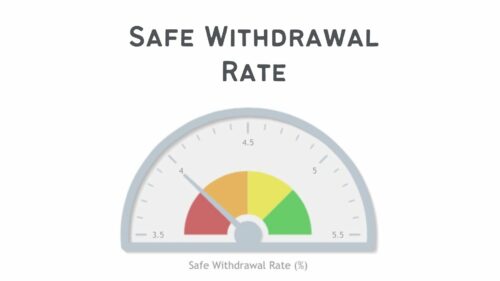This article has incorrect information in it. On purpose. Read it, see if you can find the flaw, and then read “Beware the Rules of Thumb” to find out why I put the flaw in there!
“I’m spending a year dead for tax reasons.”
– Douglas Adams

I was recently on my way back to Fort Worth from a 401k conference when I had a revelation.
There were no angels. I was in a plane at 35,000 feet, so seeing angels and halos might have made me panic.
The conference was focused on how to get more people involved in their 401k programs at work.
A series of speakers trotted up to the stage to talk about their target date funds and how well they were performing.
Surprisingly, most of the target date funds were meant to keep you appropriately invested until retirement, but not after retirement.
That’s another topic for another day.
But, they almost all used examples of Joe and Jane Couple (who must get a flood of junk mail) who work until age 65 or 66 and then retire. Joe and Jane Couple knew that they could retire because they’d hit the amount necessary to have a 4% safe withdrawal rate.
The problem is, that’s where the narrative stops.
It’s time to change the story.
But, first, let’s look at what the 4% safe withdrawal rate is. Then, we’ll examine why it’s the wrong metric for retirees to focus on.
What is the Safe Withdrawal Rate?

I cover this topic in deeper detail in the article “Is 4% the Correct Safe Withdrawal Rate at Retirement?“, so I’ll give a brief overview of this magical percentage and why financial planners think it’s so important and let you read the other article for more in depth analysis.
The number one concern that retirees have regarding their money is whether or not they’ll run out of money before they run out of heartbeats. Nobody wants to be the cat food lady or the dumpster diver at the ripe old age of ninetysomething.
In order to answer that question, William Bengen conducted what would become a seminal study on the maximum amount that a retiree could withdraw in a given year and still have money left over at the end.
He evaluated 30 year periods starting at the beginning of the history of the stock market and ran simulations for retirees who retired in each of those years. This rerun of history, called aftcasting, allowed him to choose the highest possible withdrawal rate that each of these hypothetical retirees could have withdrawn each year without running out of money after 30 years.
That amount, called SAFEMAX, is a little over 4%.
Hence, we have the 4% safe withdrawal rule.
So, in planning, we figure out how much you’ll spend at 65. We subtract out how much you receive from Social Security and pensions. We then multiply that number by 25, and that becomes your supposed target for assets.
It’s a reasonable approach for figuring out what your target number is to have saved up by the time you retire.
However, just like those target date funds that focus on getting you to retirement, and not through retirement, it falls short and leaves you on your own once you’re in retirement.
Why the 4% rule falls flat in retirement?

In essence, financial planners who tell retirees to live by the 4% rule are potentially setting them up to have a roller coaster ride of lean years and gravy years.
Let’s look at what happened for a family who was projected to need $40,000 per year above Social Security and pension payments at age 65 in 1982. They were invested in the market in a 110 – age stock allocation and had the remaining money in 10 year Treasury bonds.
Sources: http://www.usinflationcalculator.com/inflation/historical-inflation-rates/ and http://pages.stern.nyu.edu/~%20adamodar/New_Home_Page/datafile/histretSP.html
While, over time, their inflation-adjusted spending increased – the red line – they went through some serious swings in lifestyle, as shown by the blue line. They went from expanding lifestyle 15 – 20% to contracting it by 10%. Round-the-world cruise one year to camping in the local park the next year.
At least that retiree had a standard of living that increased over time.
Let’s look at what happened to a retiree who stopped working in 1929.
Oof. Not only does the general standard of living decrease over time, this poor retired family has wild swings from year to year.
How many of us want to face a future of wild, random swings in our standard of living? Raise your hands.
You, in the back. You’re crazy!
As we discussed in “The Life Cycle Saving and Investing (LCSI) Approach,” in an ideal world, you have spending that increases just a little bit each year until you reach an age where you can no longer consume as much as you once could (think decreased travel and eating less because you’re not physically able to get around like you once did).
Having a whipsaw of spending and belt tightening is exceptionally stressful. We become adapted to a certain lifestyle. We like routine. Even if we are spontaneous in what we do in the moment, we like to know what we can expect this year, next year, and the year after that.
Living in retirement on the 4% rule diet prevents us from planning from year to year. We don’t know what we can do next year because we have to know what we’ll earn this year.
Therefore, we should be looking forward at our expected spending in retirement, projected inflations, and potential returns of our investments to inform us of what our target retirement savings need to be when we retire. Then, we figure out how long we have to get there and what we expect to earn on our investments over that given time. That tells us how much we need to save now.
It’s the same calculation we use when we figure out how much we need to save for our kids’ college education fund.
Yet, to avoid having to do math, we take a simple heuristic – multiply our retirement savings by 4% – and potentially subject ourselves to stress and uncertainty in retirement.
It’s not how I plan on living in retirement.
How do you calculate that retirement number based on this approach? How much should you save for your kids’ college? Please fill in the contact form, and I will connect you with a financial planner to answer those questions.
What about you? Do you feel comfortable hopping on the lifestyle rollercoaster in retirement? Let’s talk about it in the comments below!
Author Profile
- John Davis is a nationally recognized expert on credit reporting, credit scoring, and identity theft. He has written four books about his expertise in the field and has been featured extensively in numerous media outlets such as The Wall Street Journal, The Washington Post, CNN, CBS News, CNBC, Fox Business, and many more. With over 20 years of experience helping consumers understand their credit and identity protection rights, John is passionate about empowering people to take control of their finances. He works with financial institutions to develop consumer-friendly policies that promote financial literacy and responsible borrowing habits.
Latest entries
 Low Income GrantsSeptember 25, 2023How to Get a Free Government Phone: A Step-by-Step Guide
Low Income GrantsSeptember 25, 2023How to Get a Free Government Phone: A Step-by-Step Guide Low Income GrantsSeptember 25, 2023Dental Charities That Help With Dental Costs
Low Income GrantsSeptember 25, 2023Dental Charities That Help With Dental Costs Low Income GrantsSeptember 25, 2023Low-Cost Hearing Aids for Seniors: A Comprehensive Guide
Low Income GrantsSeptember 25, 2023Low-Cost Hearing Aids for Seniors: A Comprehensive Guide Low Income GrantsSeptember 25, 2023Second Chance Apartments that Accept Evictions: A Comprehensive Guide
Low Income GrantsSeptember 25, 2023Second Chance Apartments that Accept Evictions: A Comprehensive Guide

